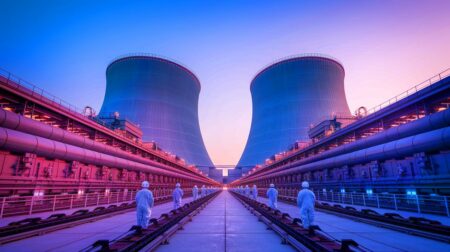Photo: Pixabay/fietzfotos
By Timur Tillyaev
In July, the European Union labelled nuclear as a green energy source, paving the way for more investment in the industry. But as more countries consider the widespread adoption of nuclear power as a solution to the current energy crisis, a major hurdle is managing and disposing waste from nuclear reactors.
Nuclear energy production leads to the generation of radioactive material. If not properly managed or disposed of, this waste can damage human health and the environment. According to the EU’s sustainable taxonomy, nuclear energy can only be classed as a transitional green energy source if, among other requirements, countries can certify the safe disposal of radioactive waste from nuclear reactors.
Currently, most used fuel is safely stored in dry storage units on the ground at nuclear power plants. However, there is no permanent solution, and current storage capabilities will not be sustainable if atomic energy is upscaled over the next few decades.
On-ground storage units also pose risks in the event of accidents or conflict. Most recently, Russia seized the nuclear power plant in Zaporizhzhya and used it as a military base to fire at Ukrainians. They did so “knowing that they [Ukraine] can’t and won’t shoot back because they might accidentally strike a nuclear reactor or highly radioactive waste in storage,” stated US Secretary of State Antony Blinken.
To eliminate such threats and find a permanent solution, it is imperative to develop and invest in new technologies. International cooperation will be needed to drive this innovation and prevent bottlenecks in greenlighting new nuclear projects.
Investment in solutions for permanent nuclear waste storage has been previously neglected. While the industry has innovated to create safer and smaller nuclear reactors, “the back-end of the fuel cycle — the management, reuse, or recycling of spent nuclear fuel — has been largely ignored as a focal point for innovation in the industry,” states energy expert Michelle Brechtelsbauer.
However, for both recycling and permanent disposal, the nuclear industry has potential solutions on the horizon that could be achieved with the right investment.
Most of the material in used fuel can be recycled. According to the World Nuclear Association, approximately 97% of nuclear waste can be used as fuel in certain reactors. Recycling nuclear waste focuses on extracting plutonium and uranium, which can subsequently be mixed with fresh uranium and made into new fuel rods that can produce energy.
In France, for example, around 17% of nuclear electricity is produced with recycled fuel. In contrast, the United States, the world’s largest producer of nuclear energy, does not recycle any nuclear waste, citing high costs and the potential proliferation of nuclear weapons.
Used fuel can also be recycled for other purposes. US-based start-up Curio, for example, has recently developed a chemical process to turn nuclear waste into usable products such as isotopes that can generate ingredients needed to produce power sources for space missions and batteries.
Curio states this process can reduce the amount of radioactive waste to less than 4 per cent of the initial total. Investment in these kinds of projects can drastically reduce the amount of nuclear waste that needs to be disposed of in the long term.
To create a sustainable nuclear fuel cycle, governments can also play a role by incentivising new power plants that use recycled fuel and removing red tape for nuclear-reprocessing facilities. Existing concerns can be addressed by collaboration with countries like France and Japan that are already safely recycling nuclear waste.
Permanent disposal of nuclear waste must also be on the agenda. A widely agreed upon solution is using underground nuclear waste repositories, selected based on their geology. It is considered a safe way to keep radioactive materials away from people without negatively impacting the environment.
Despite consensus on the safety of this method, only Finland has greenlighted a location for a repository. With the new green label, countries with significant nuclear power can work together to share research on underground storage and work towards a harmonised regulatory standard.
Countries in the EU can also develop regional and shared nuclear repositories, which would be cost-effective, sustainable, and environmentally friendly.
Now that nuclear energy has received a new impetus, the industry must build upon this momentum for an orderly European transition away from fossils. For this to happen, the nuclear industry’s waste problem must be rapidly addressed through increased investment in innovation and coordinated interstate cooperation.
Timur Tillyaev is an international businessman and investor. His business interests include energy and renewables, finance, logistics, healthcare and technology.
Did you like it? 4.4/5 (20)








